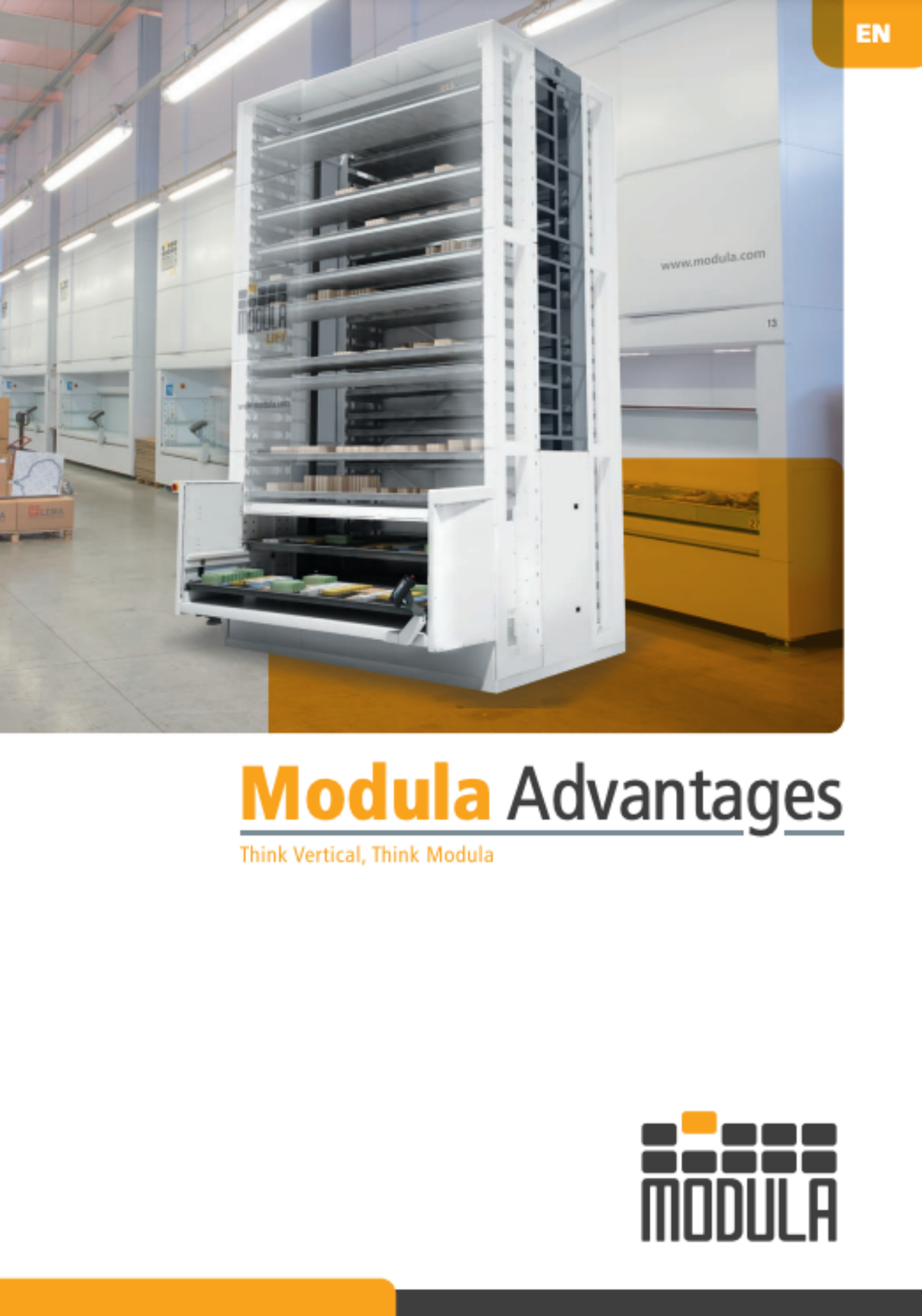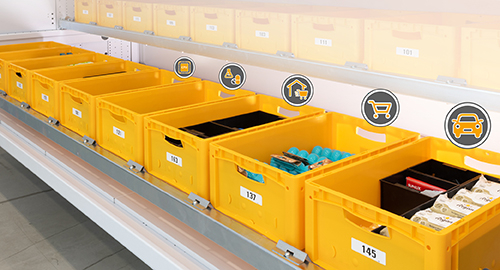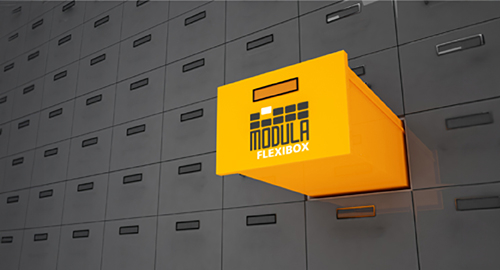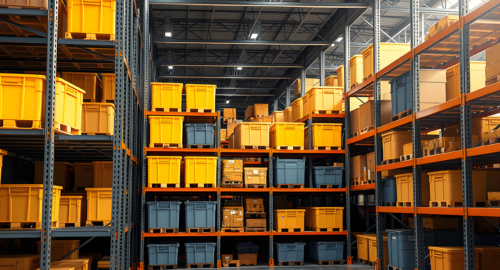Automatic warehouses have become a reality for many businesses and a necessity for countless others. However, they are not all the same, let us briefly see the advantages and disadvantages of the dvierse types of automated warehouses:
- Multi-column
- Vertical carousels
- Horizontal carousels
- Miniload
- Stacker crane
- Shuttle
- Vertical Buffer Module (or Vertical Lift Module, VLM)
1. Multi-column
Multi-column warehouses are vertical storage systems with mobile trays and multiple columns for the high-frequency picking and placing of lightweight loads. The way products are organized inside the trays allows optimal use of the space available inside the warehouse.
Trays are generally designed to be subdivided for the most effective adaptation to all storage and handling needs, to facilitate the flow of goods within the warehouse.
Benefits
- Shorter cycle times and quick access to materials
- Optimization of material flow
- High productivity level
Drawbacks
- Lower tray payload than with a VLM (Vertical Lift Module) warehouse
- Average time for access to a tray longer than with a VLM
2. Vertical carousels
Vertical carousels are automatic vertical warehouses which operate on the “revolving shelves” principle: the carousel consists of a series of shelves which rotate vertically in both directions inside the machine, conveying the goods in store into the special picking position by the shortest route.
This type of warehouse makes full use of all vertical space and ensures fast access to the materials in store. This strategy significantly reduces the time normally required to move around conventional shelving systems.
Benefits
- High picking productivity
- Optimization of space and reduction of the space occupied in the warehouse
- Very compact external dimensions, especially in depth, because unlike with a VLM, there is no need to reserve the central
- aisle for the lift
- Very fast access times and ergonomic picking position
- Well organized storage of small components
- High storage density (higher than VLM) on machines with lower height
- Ideal for locations where vertical space is limited
Drawbacks
- Limited payloads, in terms of both each shelf and the entire structure
- No load flexibility. Compartments have a fixed height and it is not easy to modify the load height at a later date
- Not suitable for storing bulky or particularly heavy materials
- The machine’s height cannot be modified if it is repositioned
- Only one input / output point
- Machine repair operations are very complicated and dangerous in the event of a serious accident, due to possible twisting
- of the two rotational axes
Various models are available, with different shelf payload, maximum system payload and overall dimensions.
Technical specifications
- Shelving maximum payload: 150 – 750 kg
- System maximum payload: 3,000 – 14,000 kg
- Carousel maximum width: 2000 – 3420 mm
- Depth: 1000 – 1720 mm
3. Horizontal carousels
Horizontal carousels are similar to the vertical type except that their axis of rotation is horizontal instead of vertical.
Like the vertical equivalent, this system consists of revolving shelves which rotate in both directions to deliver materials to the operator by the shortest possible route. Because of the horizontal layout, the picking position is not always particularly ergonomic.
This type of system may be a good solution where height is limited, such as in premises with low ceilings.
Benefits
- The best solution when height is limited or in long, narrow spaces (e.g. corridors)
- High productivity
- Warehouses can be installed side by side to further increase throughput
- Some twin carousel models are available
Drawbacks
- This solution is only efficient in some specific conditions
- The picking station is not very ergonomic
- Often affected by unbalanced weight problems
- Not suitable for storing bulky or particularly heavy materials
Technical specifications
- Different column payload levels: 450 kg, 680 kg, 900 kg
- Rotating column working height: 1800 – 3650 mm
- The system may overload itself
4. Miniload
The Miniload is a high-performance automatic warehouse with a single or twin column structure for handling lightweight loads.
This type of warehouse consists of a series of parallel shelves separated by narrow aisles along which the stacker cranes operate. The load units are stored inside cells in the shelving. The miniloads recover the load units and convey them to the picking, packaging or shipping area.
Systems have one or more loading bay depending on picking requirements. The major benefit of these solutions is that they provide a completely automatic picking system, which therefore ensures high productivity, speed and safety.
Benefits
- Various types of load unit can be used and transported
- Very high possible payload
- It is also possible to store very tall units using all the vertical space available inside the warehouse
- Pack management capability
- High general productivity
Drawbacks
- Throughput limited by having just one input / output position per channel
- Fairly expensive
- Lengthy, expensive installation
- Load unit payload and the space inside them cannot always be used to the full because of the memorized element shapes and sizes
- Not suitable for storing heavy or bulky materials
5. Stacker crane
Stacker crane warehouses are similar to Miniloads, but unlike them they are designed to handle pallets and heavy materials in general.
The system consists of a mobile frame moving up and down a vertical column, which in turn moves horizontally along an aisle between two shelving systems. This type of automated solution is used in warehouses with height in excess of 12 meters.
Benefits
- Can manage various types of load unit: pallets, containers, etc.
- Can contain very heavy and bulky materials
- Very tall heights possible
- Completely automated system
Drawbacks
- Generally fairly slow
- Not suitable for storing small objects
- Fairly expensive and difficult to implement
6. Shuttle
A shuttle automated system consists of a series of parallel shelving units divided by a narrow aisle within which the shuttles operate to pick materials from the storage position and transfer them to the lift at one end of the aisle.
Once the materials reach the lift, they are lowered to the picking point. The process is reversed during the placing process.
This type of system is extremely efficient and provides very high productivity. This system is also easy to install and easily scalable, since additional shelving units, shuttles and lifts can be retrofitted as required.
Generally used in synergy with other systems, such as Miniloads, to increase the warehouse’s overall productivity.
Benefits
- Very high picking speed and throughput rate
- Easy to install, easily scalable
- Versatile, able to manage various types of material
- The shuttle lightens the workload of the stacker crane in its channel, which may therefore be varied in size
Drawbacks
- Limited operating height
- Not suitable for handling bulky or heavy products
7. Vertical Buffer Module (or Vertical Lift Module, VLM)
The Vertical Buffer is a new type of automatic warehouse for the storage and retrieval of small lightweight components. It consists of a system of shelving units in which the containers move automatically. The real innovation here compared to other VLM systems is at the heart of its picking stations. They are equipped with a rotating table inclined at 20 degrees which is designed to ensure maximum ergonomics.
While the operator is picking an order, the machine is preparing the next container and will place it on the rear part of the table. As soon as the picking process is complete, the table rotates 180 and makes the next container available for picking.
Microload is a latest-generation VLM with the special characteristic that instead of handing 1 tray at a time, the elevator handles 4 or 5 small trays. This strategy is based on the fact that if 4 different articles, located in 4 di different trays, are requested, a traditional VLM has to perform 4 separate missions, while with the Vertical Buffer the elevator collects the 4 trays and delivers them to the picking bay in a single operation. This means an increase in the number of order lines shipped since fewer elevator missions are required.
Benefits
- High-Speed – up to 4 times higher than a traditional VLM (about 200 order lines/hour)
- Articles are loaded in standard boxes, which are easy to handle and immediately identifiable
- Containers can be delivered to the picking area in tilted position
- The machine can be installed in climate-controlled areas or refrigerated areas down to -20 °C
- Less weight on the ground compared to VLM or Carousels
Drawbacks
- Not suited to the storage of bulky or heavy materials
- Maximum load per small tray 25 Kg
- Maximum weight per elevator 125 Kg
- Machine maximum payload 40,000 Kg – very lightweight structure
The advantages of a Modula automatic vertical storage system



